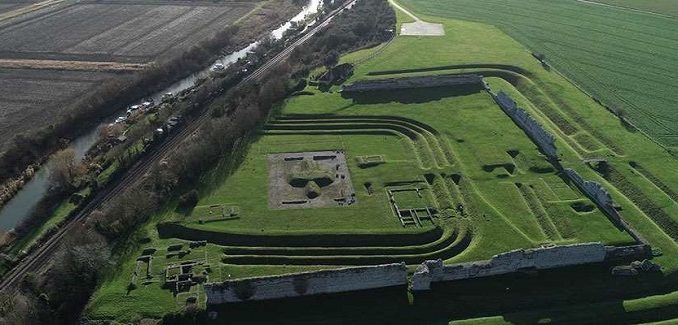
An excavation of the amphitheatre and its surrounds at Richborough Roman Fort will begin late this month.
The excavation will allow English Heritage to understand the amphitheatre’s date and relationship to the Roman fort and town at Richborough, which was occupied for the entire Roman period. The site of the amphitheatre will open to the public in spring 2021.
Historically the amphitheatre would have provided the inhabitants of the Roman town with a place for public spectacles and entertainment such as wild animal hunts, executions and occasionally, gladiatorial combat. It is considered Roman Britain’s longest-occupied site.
Richborough Roman Fort is a key site in the history of Roman Britain. It was used during the entire length of the occupation from the invasion of 43 AD until the end of Roman rule around 410.
It developed from an early fortification to a civilian town and port before returning (partially, at least) to military use. During this time the building was used as a Saxon Shore fort for protection against Saxon raiders in the later 3rd century.
Unassumingly located in the East Kent marshes, and in Roman times on the coast, Richborough is of symbolic importance in the study of Roman Britain. It is unique in that the site witnessed both the beginning and the end of Roman rule.
The amphitheatre, which lies apart from the area of standing remains (framed by walls of the 3rd century fort), shows how extensive the settlement at Richborough was. It measures more than 50 acres at its peak. However, the origins of the amphitheatre are completely unknown, and English Heritage hopes to explore several questions: what the amphitheatre looked like; when it was built, how it was used and what happened after the Romans abandoned it?
The amphitheatre was first described in written records in the mid-16th century and the only previous excavation took place in 1849. However, the records are vague. More research is needed to understand the amphitheatre’s original shape and structure and piece together existing clues which suggest a stone-walled arena surrounded by earthworks, perhaps with tiered stone or wooden seats on top.
The Victorian excavation also revealed a skeleton evidently dug into the amphitheatre, posing the question of whether the amphitheatre became a cemetery after the Roman period.
Paul Pattison, English Heritage Senior Properties Historian, said: “The impressive ruins and the enormous, rich collection of finds from previous excavations place the settlement at Richborough are amongst the most important Roman historical and archaeological sites in England.
“However until now its amphitheatre’s secrets have remained hidden below the surface. We have a number of questions we’re hoping will be answered during this dig…This excavation is a once in a lifetime opportunity to temporarily reveal these ancient remains, analyse the clues left by the Romans, and finally unlock its story.”
The excavation at Richborough Roman Fort’s amphitheatre will be carried out by specialists from Historic England, between late March and early June 2020.
A small area within the existing walls of the Fort will also be excavated to learn more about the very first phase of Richborough’s occupation in 43 AD, its Claudian gateway.
A major refurbishment and re-presentation of the on-site museum will take place in Winter 2020 and open in Spring 2021.
Tours of the site will take place during the excavation; please check the English Heritage webpage for details.
Report by English Heritage

